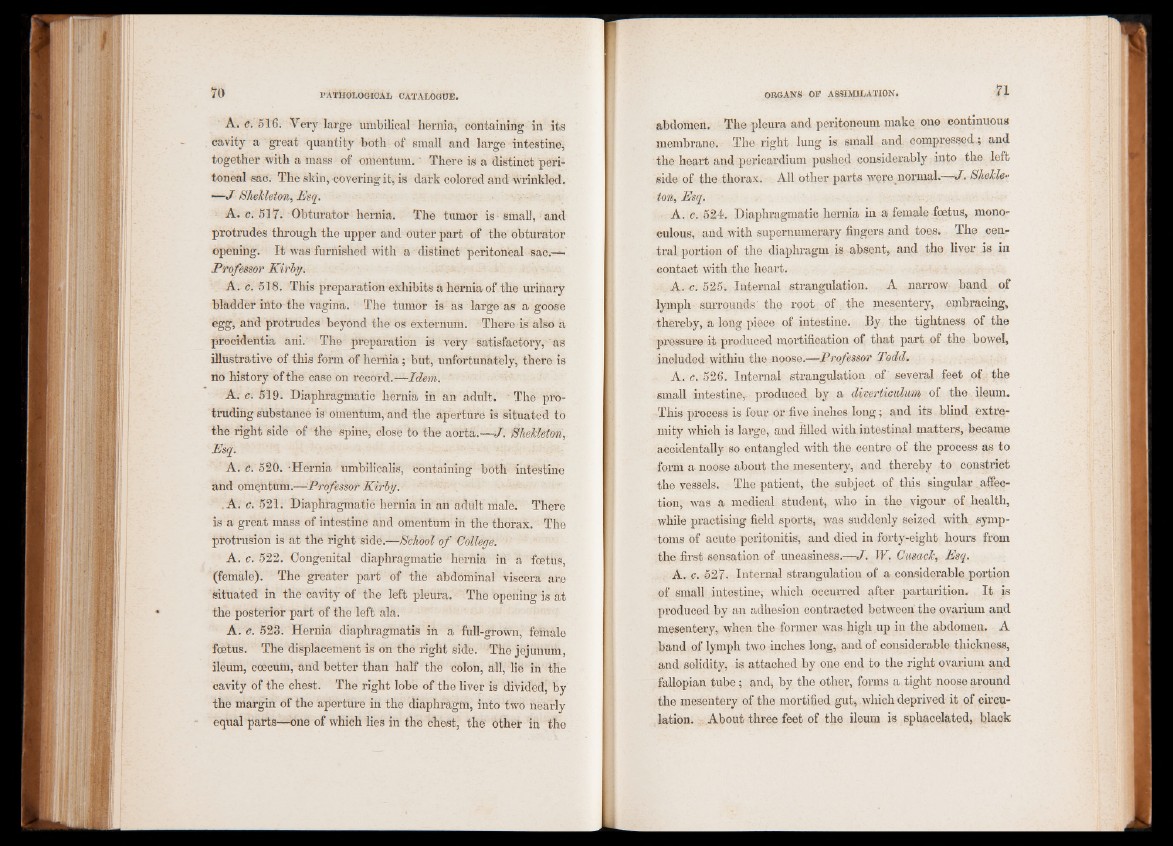
A. c. 516. Very large umbilical hernia, containing-in its
cavity a great quantity both-of small and large intestine,
together with a mass of omentum. ' There is a distinct peritoneal
sac. The skin, covering it, is dark colored and wrinkled.
■—J Shekleton, Esq.
A. c. 517. Obturator hernia. The tumor is-small, and
protrudes through the upper and outer part of the obturator
opening. It was furnished with a distinct peritoneal sac.—
Professor Kirby.
A. c. 518. This preparation exhibits a hernia of the urinary
bladder into the vagina. The tumor is as large as a goose
egg, and protrudes beyond the os externum. There is also a
procidentia ani. The preparation is very satisfactory, as
illustrative of this form of hernia ; but, unfortunately, there is
no history of the case on record.—Idem.
A; c. 519. Diaphragmatic hernia in an adult. The protruding
substance is omentum, and the aperture is situated to
the right side of the spine, close to the aorta.—J. Shekleton,
Esq.
A. c. 520. 'Hernia umbilicalis, containing both intestine
and omentum.—Professor Kirby.
A. c. 521. Diaphragmatic hernia in an adult male. There
is a great mass of intestine and omentum in the thorax. The
protrusion is at the right side.—School of College. |
A. c. 522. Congenital diaphragmatic hernia in a foetüs,
(female). The greater part of the abdominal viscera are
situated in the cavity of the left pleura. The opening is at
the posterior part of the left ala.
A. e. 523. Hernia diaphragmatis in a full-grown, female
foetus. The displacement is on the right side. The jejunum,
ileum, cæcum, and better than half the colon, all, lie in the
cavity of the chest. The right lobe of the liver is divided, by
the margin of the aperture in the diaphragm, into two nearly
equal parts—one of which lies in the chest, the other in the
abdomen. The pleura and peritoneum make one continuous
membrane. The right lung is small and compressed; and
the heart and pericardium pushed considerably into the left
side of the thorax. All other parts were normal.—J . Shekle-■
ton, Esq.
A. c. 524. Diaphragmatic hernia in a female foetus, monoculous,
and with supernumerary fingers and toes. The central
portion of the diaphragm is absent, and the liver is in
contact with the heart.
A. c. 525. Internal strangulation. A narrow band of
lymph surrounds the root of. the mesentery, embracing,
thereby, a long piece of intestine. By, the tightness of the
pressure it produced mortification of that part of the bowel,
included within the noose.—Professor Todd.
A. c. 526. Internal strangulation of several feet of the
small intestine, produced by a diverticulum of the ileum.
This process is four or five inches long; and its blind extremity
which is large, and filled with intestinal matters, became
accidentally so entangled with the centre of the process as to
form a noose about the mesentery, and thereby to constrict
the vessels. The patient, the subject of this singular affection,
was a medical student, who in the vigour of health,
while practising field sports, was suddenly seized with symptoms
of acute peritonitis, and died in forty-eight hours from
the first sensation of uneasiness.—J. W. CusacJc, Esq.
A. c. 527. Internal strangulation of a considerable portion
of small intestine,- which occurred after parturition. It is
produced by an adhesion contracted between the ovarium and
mesentery, when the former was high up in the abdomen. A
band of lymph two inches long, and of considerable thickness,
and solidity, is attached by one end to the right ovarium and
fallopian tube; and, by the other, forms a tight noose around
the mesentery of the mortified gut, which deprived it of circulation.
. About three feet of the ileum is sphacelated, black